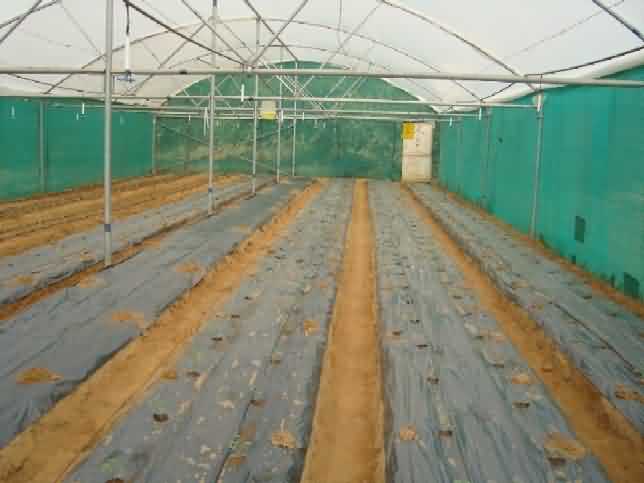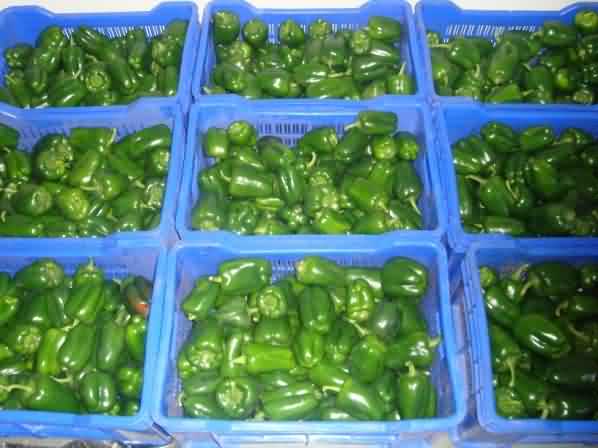रंगीन शिमला र्मिच उगाने की विधि।
Capsicums are grown under shade net houses and green houses to get good quality and better yield round the year.
Climatic requirement :
Day temp (0C) =21-28, Night temp (0C) = 18-20 , Humidity 9%) = 60-65, Light intensity (Lux) = 50000-60000
Selection of planting material for capsicum cultivation:
- The planting material should be healthy, resistant to diseases & pests.
- Age of the seedling should be 35 to 40 days old.
- Height of the seedling should be 16 – 20 cm.
- Plant should possess good rooting system.
- Seedling should have at least 4 – 6 leaves on the stem at the time of plantation.
Other characteristics like fruit shape, fruit colour, production, fruit quality and vigour should also be considered while selecting plant material of good variety of capsicum.
In case of capsicum either seeds (20 gms) for 1008 sqm. should be procured for making seedling at site or seedling should be purchased from the nurseries.
Varieties mostly grown in India:
| S.No. | Variety | Colour |
| 1 | Bomby | Red |
| 2 | Orobelle | Yellow |
| 3 | Indra | Green |
Steps in plantation of Capsicum:
- Pebbles, clods etc. should be removed from bed surface.
- Adequate moisture must be available in the soil at the time of plantation.
- The seedlings should be dipped in Bavistin (0.2 %) solution at the time of plantation.
- Plantation to be done by making holes or trenches on bed in a zigzag method.
- Planting should be avoided during the hottest period of the day/year & should normally be done during morning hours or late in the evening.
Care after plantation:
After plantation, the soil around the plants must be kept humid but not soaking wet. Irrigate the plant with hose pipe immediately after plantation.
During periods with strong sunshine or high temperature, the young plants must frequently be given an over head spray of water to assist establishment & reduce post planting losses. For first three weeks the irrigation should be done only by using hose sprayer & later on irrigation should be done by drip system.
Procedure for planting capsicum
Bed preparation:
A raised bed of red laterite soil is always preferred for plantation of capsicum or sweet pepper. Bed should be highly porous, well drained, providing adequate aeration for root development. The raised bed of capsicum plantation should have following dimensions.
Plantation:
The bed should be irrigated with water and kept wet at the time of plantation. Capsicum seedling should be sown in two rows on the raised beds.
Plantation of capsicum can also be done on raised bed with plastic mulch in order to save water and checked the growths of weeds.
Planting method:
Two rows of Capsicum seedlings are planted in a zigzag method on the bed.
Planting distance:
Plant to Plant distance: 40 cm
Row to Row distance: 50 cm
|
Sr. No. |
Area of poly house (m2) |
Planting density |
Total plants required |
|
1 |
560 |
2.5- 3.5 plants/ m2 |
1400- 1960 |
|
2 |
1008 |
2.5-3.5 plants/ m2 |
2520- 3528 |
Fungicides drenching schedule:-
|
S.No. |
Fungicide |
Dose |
Time of drenching |
|
1 |
Bavistin |
1 g/litre |
Immediately after plantation |
|
2 |
M – 45 |
1 g/litre |
3 days after plantation |
|
3 |
Bavistin |
1.5 g/litre |
7 days after plantation |
|
4 |
M – 45 |
1.5 g/litre |
10 days after plantation |
|
5 |
Bavistin |
2 g/litre |
14 days after plantation |
|
6 |
M – 45 |
2 g/litre |
17 days after plantation |
Quantity of water 50 ml/plants to be used while drenching.

Plantation of Capsicum seedlings on mulch bed
Cultural practices:
Capsicum is a nine months to one year crop and production starts after 60 to 75 days from the date of plantation. The different cultural practices to be carried out are as below:
Crop support:
Some varieties are very vigorous & plant can become as tall as 3.5 m and they produce about 4 - 5 kg fruits on one plant in their life cycle. As stems are weak, they need support system.
Plant stem after transplantation is tied by a high density plastic or nylon string. Twines are vertical ropes that are tied to horizontal wires on the ceiling at one end and to the crop at another end.
Twines of good quality are used to hang from horizontal wires at least 3 m above the ground. Horizontal wire used should not have thickness less than 12 gauge, as it supports the weight of all plants in the row.
If the wire is weak it will break and lead to losses. Three rows of over head horizontal wires are required for one bed and for each single plant four numbers of twines are required. 
Topping:
The growing point at the top of the plant are removed. This operation is called topping. This technique is adopted for producing more branches. This is practiced after one month period from transplantation.
After topping two or four main leaders are kept where as the lateral shoots are pinched first leaf (internodes) or second leaf (internodes). One or two fruits per side shoot are maintained.
Systems of training in capsicum cultivation:
Generally two system of training are practiced in capsicum cultivation.
Two – leader system of training : In this system of training two main shoots are maintained as two leaders after topping. Side shoots are pinched after one or two pairs of leaves; generally one fruit is kept per side shoot.
Four - leader system: In this system of training four main shoots are maintained as four leaders after topping. Side shoots are pinched after one or two pairs of leaves; generally one fruit is kept per side shoot.
Fruit thinning:
When there are too many fruits on the plant, it is necessary to remove some fruits, to promote the development of remaining fruits.
This operation is called as fruit thinning. Fruit thinning is done when the fruit is of pea size.
This practice is normally followed to increase the size of fruit thus by increasing the quality of production. 
Pollination:
Capsicum are self pollinating but there is high degree of cross pollination because of honey bees, thrips and other insects who transfer pollen from blossom to blossom.
Pollination is not improved by using an “ electric bees” or by spraying plant hormones but pollination is clearly better when honey bees or bumble bees fly in the green house. Bees increase the number of seeds in capsicum fruits.
Maturity indices:
Harvesting of capsicum is done at green, breaker and coloured (red/ yellow etc.) stage. It depends upon the purpose for which it is grown and distance for the ultimate market.
In India fruits are harvested at breaker stage for long distant markets. For local market, it is better to harvest coloured stage.
Breaker stage is the one when 10% of the fruit surface is coloured and when more than 90% of the fruit surface is coloured it is considered as coloured stage.
Harvesting: Harvesting starts after 60 to 75 days after transplanting & should be done with the help of sharp knife. Harvesting at the proper stage of maturity, careful and minimal handling of the produce will help in maintaining better fruit quality and reduce storage losses.
Harvesting is generally done during morning and evening hours. Avoid harvesting immediately after fogging to check the disease and pest under control and to maintain better keeping quality of fruit. Generally, the yield of capsicum is 8 to 10 kg/ m2. Harvesting of capsicum is done by skilled worker in green house and kept in plastic containers and send to the packaging hall.
Post harvest management of Capsicum:
Cleaning and Grading:
All damaged, malformed and bruised capsicums should be removed. Those with dirt adhering to their surface can be cleaned by wiping the surface with a moist soft cloth. The capsicums should be graded into same size and colour lots according to market requirements.
Sorting:
Sorting is done on the basis of shape and weight of capsicum.
Packing:
Capsicum is packed in cartons and should hold about 10 kg or 12 kg of capsicum. Mostly farmers use apple boxes (used ones) for packaging capsicum for local market.
An ideal corrugated boxes carries following in formation.
- On top side of the lid “Fresh vegetables” is printed.
- On width wise side of the lid “Variety, number of capsicums, gross and net weight of box, box number is written on both sides.
- On length wise side of the lid “Fresh vegetable and handle with care is written on both sides.”
- Senders and buyers address with phone number.
Storage :
Capsicums can be stored in a cool room at a temperature of 7–10 °C for up to 3 weeks if required.
Post harvest operation in Capsicum


Grading of Capsicum
Polythene packaging of Capsicum
Packed in a collapsibleplastic crate (Domestic Market)


Display of coloured Capsicums
Author:
Dr. Satya Narayan Choudhary
Asstt. Trainer, International Horticulture Innovation and Training Centre,
Durgapura- Jaipur
Email:








